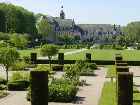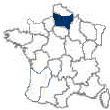|
Abbéville
Abbeville is a town in the Département of
Somme. Its original site was as an island, in the Somme Estuary, where the local inhabitants fled from Viking attacks. Today, it is still partly located on an island and partly on the river’s banks, at the head of the Abbeville Canal. It is 28 miles northwest of
Amiens and 12 miles southeast of the English Channel.
Stone Age artifacts, unearthed in 1844, indicate that the site was settled in the Paleolithic Period and was important in the Bronze age. The artifacts are displayed in the Musée de Crèvecoeur de Perthes which was named after the man who unearthed them.
The Romans named the town Abbatis Villa. Abbeville, by the 9th century, was a dependency of the wealthy Benedictine abbots of Saint-Riquier. By this time, the town had become a fortress for the defense of the mouth of the Somme. In 1131, the Normans burned down the Carolingian and Romanesque abbey. In 1184, the town was granted a charter as a commune. The abbey wasn’t rebuilt until the 13th century.
First the English and then the French took turns at ruling Abbéville. From 1272 to 1435, the city was ruled by the English and was the capital of Ponthieu. The marriage of
Louis XII and Henry VIII’s sister, Mary, took place in
Abbeville. In 1435, the first battle of
the Hundred Years’ War took place just to the north. The city then quickly fell prey to the
dukes of Burgundy.
Louis XI annexed the town in 1477. It latter grew into an important industrial and commercial city.
The
Edict of Nantes, which bestowed upon French Protestants partial religious freedom, was revoked in 1685. As a consequence of the revocation, Abbeville suffered a severe economic blow that was caused by the flight of Protestant skilled labor from the town.
In May, 1940, the rapidly advancing German army took the heights overlooking the town. The Germans quickly strengthened the natural defenses of the area. General Charles de Gaulle, without support, organized a counter attack by his Fourth Armored Division, against the German Panzers, on May 27-29, driving deeply into the enemy’s lines. However, due to the ineptness of the fossilized French General Staff, he was unable to follow-up his victory.
The German army entered Abbeville in June, 1940 after seriously damaging the city. The Gothic cathedral of Saint-Vulfran’s 17th century vaulted choir was almost completely destroyed. The town hall [Hôtel-de-Ville], with its 13th century tower, survived.
Carpet factories were established in the city during the 17th century. Breweries, ironworks and sugar beet refineries were also installed in the city.
The Capital of Picardy - Amiens
The ancient cathedral city of Amiens is the capital of the region of
Picardy and of the Département of the
Somme. It is situated on the Somme River, along a route long used for trade and by invading armies. It is about 75 miles north of
Paris, 68 miles northwest of
Reims, 71 southwest of Lille and 28 miles southeast of
Abbeville. It is the principal city of the Somme River valley.
In pre-Roman times the city was known as Samarobriva and was the capital of the Ambiani Gauls. The name Amiens was derived from Ambiani. Amiens became a Roman colony and, in 54 BC, [during the Gallic War] Julius Caesar set up his headquarters here. For the next four and one-half centuries the town was a stronghold of the Roman Empire. Saint Firmin, the city’s first bishop, Christianized it in the 4th century.
Amiens became a part of the medieval countship of Amiénois, where there was continuing friction between the count and the bishop. It was given a charter, as a commune, early in 1117.
The city was, for centuries, a major fortress guarding Paris from attack from the north. The old citadel still stands, but the ramparts have been converted to boulevards. In 1264 the French and English signed a truce here. Upon the death of
Charles the Bold, in 1477,
Amiens became a possession of the French Crown.
In 1802, the
Treaty of Amiens was signed between the British, French, Spanish and Dutch. This marked only a short pause in the Napoleonic Wars. Under the treaty, England was required to give up most of the territory it had taken in previous fighting. In May, 1803, the fighting was restarted by the English. Because of
Napoleon’s fear that the French would not be able to defend the
Louisiana Territory, the possession was sold to the United States for a paltry sum. The warring period, from 1803 to 1815, is known as the Napoleonic Wars.
Prussian forces took Amiens during the
Franco-Prussian War of 1870. During World War I the town was a British Army base, due to its commanding position on the Somme River and its proximity to rail transportation. In 1914, the Germans managed to enter Amiens before being beaten back to trench positions some 18 miles to the east. The German’s final drive of the war, in 1918, was stopped just 8 miles to the east of the town. The German bombardment of the city, during WWI, resulted in cathedral damage by artillery shells and bombs.
In 1940, during World War II, a substantial bombardment of Amiens preceded the German occupation of the city. The city’s center required rebuilding after the war.
The old city, which is dominated by its Gothic cathedral, contains numerous buildings dating from the Middle Ages. The cathedral is one of the three most famous High Gothic cathedrals in France and boasts a seldom seen homogeneity of style. Notre-Dame Cathedral, which is one of the world’s most beautiful monuments to Gothic architecture, is also France’s largest Gothic cathedral, covering 89,875 square feet.
The French architect, Robert de Luzarches, designed the cathedral along the lines of the Cathedral at
Reims. Work on the cathedral began in 1220 and was financed by profits made on the sale of a plant valued in making blue dye. It was built to house the head of Saint John the Baptist that was brought back from the 1206 crusade. A galleried façade, with a rose window and is pierced by three portals, was completed in 1236.
Thomas de Cormont took over construction from de Luzarches, and oversaw the construction of the choir and apse through the end of 1241. In 1269, Renaud de Cormont, the son of Thomas, completed the east end in the Ravonnant style. Twin towers top this beautiful façade. The portals and towers create a stunning High Gothic sculptural group. It is among the worlds most famous of High Gothic cathedrals, and has been designated as a World Heritage Site by UNESCO.
The cathedral’s spacious interior utilizes the dramatic open characteristics of Gothic design combined with a Romanesque logic. Its nave sores to the height of 143 feet and contains 7 bays averaging just over 40 feet [14.6m] wide and just over 150 feet [54m] long. The cathedral is 470 feet long and is supported by bold supporting columns. Some 4000 16th century wood figure carvings, representing residents of Amiens, decorate the 110 oak choir stalls that were made between 1508 and 1522. The cathedral’s lead-covered wooden spire is the oldest in France. It highest point is over 307 feet [112m] above ground and over 153 feet [56m] above the cathedral’s roof. Construction was begun in 1220 and was finished in about 1270. Further additions to the cathedral were made through the 19th century.
The 17th century town hall, which is in the center of the old town, was almost completely rebuilt in the 19th century. The 15th century Church of Saint-Germaine is situated to the town hall’s north. The Picardy museum, which is located to the south, displays medieval religious sculpture, houses a collection of 16th through 20th century paintings, 19th century marble and bronze sculptures and archaeological finds.
The town houses many other treasures. There is an ancient theater with a Louis XVI façade, la Maison à la Tour [the house that Jules Verne lived in], the Quartier Saint-Leu, which is crossed by a network of flower-lined Somme canals with water-side artisans’ shops, bars and restaurants and, to the east, a colorful area of marshland market gardens known as Les Hortillonages. The
University of Picardy, which was founded in 1965, is also located in Amiens.
Amiens is a commercial, industrial and railroad center. The city engages in food processing and manufactures carpets, chemicals, machinery, metal goods, perfumes, textiles [cotton, silk and woolen], and tires. Its textiles have been famous since the Middle Ages. There is also a brisk trade in grain, macaroons [the town’s specialty], oilseeds, sugar and wool. Truck farmers, from the surrounding areas, bring their goods to the town market by small boat.
- The Capital’s Location
- The Capital’s History
- The Capital’s Points of Interest
- The Museums
- The Churches
- The Chateaux
- The Restaurants
Beauvais
The town of Beauvais is the capital of the
Oise Département of Picardy. It is located south of
Amiens and 41 miles north of
Paris at the confluence of the Avelon and Thérain rivers. It is on both the Autoroute du Nord and Route National 1.
The town dates from a time prior to the Roman conquest when Beauvais was the capital of the Gallic Belloveci tribe. When the Romans took the town, they called it Caesaromagus. The town was latter known, by the Romans, as Civitas de Bellovacis and then as Bellovacum. In 1472, the town fought off a siege by the duke of Burgundy. Suddenly, just when the town’s people were at the point of capitulation, Jeanne Lainé [Jeanne Hachette] rallied them. She killed an enemy soldier with an ax and pulled down the Burgundy flag he had planted. This sole act revived the defense until reinforcements could arrive. An annual celebration, held in June, commemorates her heroism.
Beauvais became a countship in the 9th century. In 1013, the bishops, to whom Beauvais had passed, became peer of France. In 1096, Beauvais became a commune. The peasant revolt of 1357, which was known as the Jacquerie, had its beginnings here.
By the 17th century, Beauvais was known for its industry. It was then that the French statesman, Jean-Baptiste Colbert, initiated tapestry manufacturing in the city. During the 17th and 18th centuries the Beauvais tapestry factory fabricated tapestries of exceptional quality.
The city was badly damaged in both world wars. In 1918, during WWI, Marshal Ferdinand Foch directed Allied battle operations from the town hall. The tapestry factory was destroyed in June, 1940, during WWII. Today, having been rebuilt after the wars, Beauvais is a modern city.
Ancient Roman ramparts can be found within Beauvais with the town clustering about its principal monument, the Carolingian Cathedral of Saint-Pierre. It was begun in 1225, by the Bishop of Beauvais, and was never completed. It was to have been the largest cathedral in Europe. Its vault was to have been 157 feet high. However, it collapsed in 1272 and again in 1284.
Today, it is a remarkable Gothic structure, standing only as chapels, a choir [which is 157 feet long and is the loftiest ever constructed], and a transept. The transept and the apse have survived several collapses. The Basse Oeuvre, a Romanesque church, built in the 10th century, stands in the area planned for the cathedral’s nave. Its stained glass windows, erected in the 12th, 13th and 14th centuries, stand 52 feet high. A magnificent 90,000 part astronomical clock stands near the north entrance; it was assembled in the 1860s.
The nearby Bishop’s Palace was built in the 12th-century. It is now the Musée Départemental de l’Oise, housing archaeological finds, local ceramics, a collection of rare furniture, medieval sculpture, 17th and 18th century paintings from the French and Italian schools and beautiful local tapestries.
The Church of Saint-Étienne has a Jesse Window on the choir’s north side. Its luminous blue background and transparency make it a masterpiece. Other public buildings date from the 14th century to the 16th.
Today, the city’s products consist of blankets, carpets, ceramic tiles, chemicals, felt, food products and tractors. |



